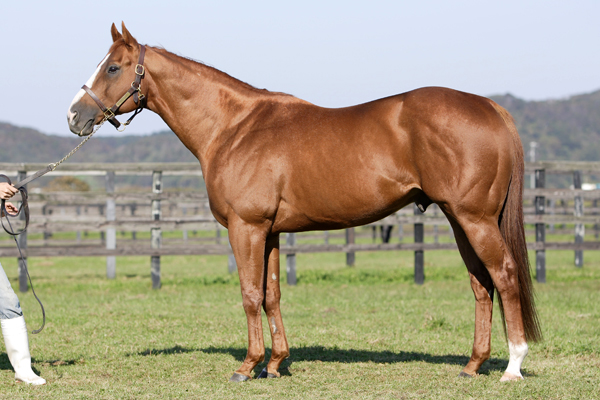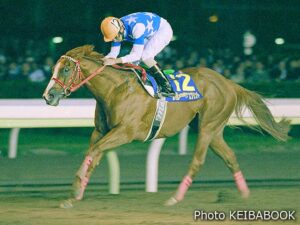In a typical year, 1,600 Pennsylvania-breds compete on the racetrack for average earnings of $27,600. Of the 50,000+ who have raced across the globe since 1985, only an elite group of 31 horses have broken the seven-figure mark in earnings. Over the course of summer 2020, the Pennsylvania Horse Racing Association will be chronicling a ten-part series featuring the select group of Pennsylvania-breds who reached the unique and rare accomplishment of $1,000,000 in racetrack earnings. Join us to celebrate and remember some of the greatest racehorses the Keystone State has produced.
Alphabet Soup: Classic Champion
Georgia Ridder’s Alphabet Soup accomplished something no Pennsylvania-bred has accomplished before or since: he won America’s richest horse race.
The story starts with the hard-knocking racemare Illiterate, a daughter of legendary racehorse Arts and Letters whose ten wins in sixty-seven career included back-to-back Grade 3 scores in the Affectionately and Interborough Handicaps.
Illiterate was owned by storied Tartan Farm, and they retired and bred her first four foals before opting to send her through the sales ring in 1986. Thomas Whitney purchased the mare for $150,000, but he ended up sending her back through the ring only a couple years later. This time failing to sell for a mere $24,000, Illiterate ended up being privately purchased by a Pennsylvania-based group of breeders by the name of Southeast Associates.
Roy S. Lerman – longtime trainer, breeder, and owner – was the head of Southeast Associates when Illiterate settled into Pennsylvania. With her 1989 foal born in late May, Illiterate was given the year off before Lerman bred her to Cozzene the following year for her first foal on behalf of Southeast Associates. On March 31, 1991, Illiterate delivered a soon-to-be gray colt in Pennsylvania.
Lerman attempted to sell the colt at auction not once, but twice with no success. He failed to sell on a $28,000 bid as a yearling and a $29,000 bid as a two-year-old before opting to sell the colt privately, and the privilege went to Georgia Ridder’s Ridder Thoroughbred Stable.
Georgia Ridder and her husband Ben had had great success as owners in California, campaigning the likes of multiple Grade 1 winner Flying Paster and champion Cascapedia. Following her husband’s passing in 1983, Georgia Ridder kept the racing stable alive. She was 79-years-old when she purchased the gray colt from Roy Lerman.
Ridder named the colt Alphabet Soup and sent him to the barn of SoCal trainer David Hofmans. While he didn’t start as a two-year-old, Alphabet Soup was ready to go by April of his three-year-old season, and he debuted at Santa Anita Park with a third place finish. Following a subsequent fourth on grass, he returned at Hollywood Park on May 11, 1994 to eke out a maiden victory by a head.
Stepping up to the allowance ranks, it took Alphabet Soup four tries to find the winner’s circle again, but he reeled off back-to-back victories at Del Mar and Santa Anita before trying the stakes ranks for the first time. He finished second by a neck in the Grade 3 Volante Handicap on the grass before ending the year with a fifth place in the G3 Laz Barrera.
Not returning until the following July, Alphabet Soup opened his four-year-old campaign with a third place effort in allowance company before returning for stakes. Taking on the Harry F. “Bud” Brubaker Handicap, the colt sat just off the pace before drawing away to a three length, 11-1 upset in the snappy time of 1:40.93 for a mile and a sixteenth. Stepping back to the graded level, Alphabet Soup took on the Grade 2 Del Mar Handicap. Settling in midpack early, the colt rallied from six lengths back to take the lead by the top of the stretch before prevailing by a hard fought ¾ length over a closing Lykatill Hill.
Following close third place finishes in the G2 Goodwood and G3 Clark Handicaps, Alphabet Soup ended his four-year-old year with a dominant 7 ½ length victory in the Grade 3 Native Diver Handicap.
Returning only twenty-three days later to kick off his 1995 season, Alphabet Soup picked up where he left off. Dueling throughout most of the Grade 2 San Pasqual, he took the lead turning for home and drew away to a 1 ¾ length score.
Quickly becoming a rising star in Southern California, Alphabet Soup returned off another short layoff, this time eighteen days, for a rematch with the talented Soul of the Matter in the G2 San Antonio Handicap. Soul of the Matter had defeated Alphabet Soup by 1 ¼ lengths in the Goodwood Handicap, and he was making his first start since finishing fourth behind Cigar in the Breeders’ Cup Classic. With Soul of the Matter the even money favorite, Alphabet Soup ended up the 2-1 second choice in the short field of five.
With Alphabet Soup sitting just ahead of his rival early on in the race, Soul of the Matter made a sudden move at the ⅜ pole to move from fourth place to the lead. Having already lost the jump, Alphabet Soup launched his bid soon after to close the gap by the time the field turned for home. With both Soul of the Matter and Alphabet Soup dead even, the two of them dueled down the Santa Anita stretch. Slowly but surely, Alphabet Soup stuck his nose in front and pulled his way to a neck victory to enact his revenge.
With the Grade 1 Santa Anita Handicap a month later, Alphabet Soup was making his fifth start in less than two-and-a-half months. The tough schedule must have finally caught up to him because the gray put up little effort and checked in tenth of eleven. Trainer David Hofmans recognized that his charge was in need of a break, and he sent Alphabet Soup to Georgia Ridder’s Hidden Springs Ranch for a few months of R&R.
Returning off his five-and-a-half month break, Alphabet Soup took on the Grade 3 Pat O’Brien Handicap at seven furlongs. Off at 5-1 odds behind talented sprinter Lit de Justice, Alphabet Soup settled into third as the two frontrunners cut out blistering early fractions of 21.93 and 44.14. With Lit de Justice trailing far behind, Alphabet Soup got the jump on the frontrunners and closed within a length of leading Boundless Moment by the top of the stretch. With Boundless Moment spent from his fast pace, Alphabet Soup burst to the front and began pulling away as Lit de Justice hopelessly tried to close from the back of the pack. By the time he hit the wire, Alphabet Soup was 3 ½ lengths in front of Boundless Moment and Lit de Justice. Lit de Justice would go on to win the Breeders’ Cup Sprint in his next start and was eventually named 1996 champion sprinter.
Stretching back out to two turns, Alphabet Soup looked to defend his title in the G2 Del Mar Handicap. Sitting in second early on, frontrunning Dramatic Gold was able to carve out easy fractions and had plenty left for the stretch run. Alphabet Soup tried to close the advantage but could only get within a neck of the leader by the finish line.
With the Breeders’ Cup World Championships the end goal, Alphabet Soup penciled in the Goodwood Handicap as his final prep race. Only four horses lined up, but the field certainly wasn’t short on talent. Lining up alongside Alphabet Soup was Savinio, winner of the San Diego Handicap and third behind Dramatic Gold and Alphabet Soup in the Del Mar Handicap, and Dare and Go, who was fresh off a 39-1 upset in the Pacific Classic, where he snapped Cigar’s legendary sixteen race win streak.
When the gates opened, Alphabet Soup began to drop in towards the rail from his far outside post. With Savinio and Dare and Go also moving into a forward position, things got a bit more crowded than expected. While attempting to take both the rail and the early lead, Alphabet Soup forced Savinio in a bit. Dare and Go, between Savinio and the rail, ended up in tight quarters and was forced to take back as his rivals came over. Meanwhile, Alphabet Soup and Savinio moved as one into the turn and set reasonable fractions. Closing Savinio’s gap around the far turn, Alphabet Soup took command and cruised to an easy one length victory over Savinio with Dare and Go another two lengths back in third. Or so it seemed.
The stewards instantly lit the inquiry sign and began reviewing the early moments of the race when Dare and Go was forced to check. Minutes later, the stewards announced that Alphabet Soup would be disqualified and placed third behind Dare and Go after determining that he was the aggressor of the chain reaction. Dare and Go was elevated to second and Savinio inherited the Goodwood Handicap victory. It ended up quite a controversial decision among racing fans.
Although bruised by their stripped victory, the Alphabet Soup camp still marched on to the Breeders’ Cup. Held at Woodbine Racetrack in Ontario, Canada for the first time, Alphabet Soup left Southern California for the first time in his racing career. Although the Breeders’ Cup Classic was shaping up to be a full field, much of the press revolved around one horse: defending champion and Horse of the Year, Cigar.
Cigar was entering the Breeders’ Cup Classic off of only his second loss in his past eighteen starts. After his sixteen race winning streak ended to Dare and Go in the Pacific Classic, Cigar returned to New York to add the Woodward Stakes to his resume before falling a head short to the up-and-coming three-year-old Skip Away in the Jockey Club Gold Cup. Skip Away was passing on that year’s Breeders’ Cup, and fans still had the utmost hope in Cigar becoming the first repeat winner of the Breeders’ Cup Classic.
A field of thirteen ended up assembling for the 1996 Breeders’ Cup Classic. While Cigar would go off the heavy 3-5 favorite, the field also included Dare and Go, Whitney Handicap winner Will’s Way, Belmont Stakes and Super Derby victor Editor’s Note, and Preakness winner Louis Quatorze. Despite his last out “victory” in the Goodwood Handicap, Alphabet Soup was discounted at lukewarm odds of 19-1.
When the gates opened, Dare and Go’s pacemaker Atticus set out and put down a hot early pace as Alphabet Soup settled directly behind the frontrunner alongside Louis Quatorze and 101-1 longshot Mt. Sassafras. Cigar found himself in midpack, and he began to pick off horses heading into the far turn, but he was stuck incredibly wide when forced to go some seven paths off of the rail. With Cigar closing in on the outside, Alphabet Soup and Louis Quatorze moved in unison.
With Atticus giving way as they approached the top of the stretch, the quartet of Mt. Sassafras, Alphabet Soup, Louis Quatorze, and Cigar turned for home as one. Mt. Sassafras desperately tried to maintain his narrow advantage over his three rivals, but they chipped away at his lead approaching the final furlong. With Cigar glued to his outside and Louis Quatorze glued to his inside, Alphabet Soup poked his head in front of his dueling rivals as they engulfed Mt. Sassafras. With his white head leading home the charge in the final yards, Louis Quatorze and Cigar attempted one, final push towards the wire, but it was too late. Alphabet Soup’s gray nose hit the wire just in front of Louis Quatorze, with Cigar another neck back in third. Dare and Go never threatened and finished seventh.
That desperate nose gave Alphabet Soup, David Hofmans, and Georgia Ridder the richest pot in North American horse racing. The $4 million Classic awarded a staggering $2,080,000 to the winner. Not bad for a horse who once couldn’t bring a bid above thirty grand.
Despite the final two races of his career resulting in losses, Cigar was still named 1996 Horse of the Year and champion older male. He would be inducted into the Hall of Fame six years later.
The Classic was Alphabet Soup’s first Grade 1 victory, and the decision was made to gear him up for a six-year-old campaign. Shortly after his big win, Frank Stronach’s Stronach Stable bought into Alphabet Soup and acquired his breeding rights to stand at Stronach’s Adena Springs Farm upon his retirement. Receiving a short break after the Breeders’ Cup, the gray was prepped for a title defense in the G2 San Antonio the following February. Returning on February 2, 1997, Alphabet Soup had a new rival waiting for him by the name of Gentlemen.
Gentlemen had reeled off four consecutive victories since traveling to the United States from his native country of Argentina, and he ended up the whopping 1-2 favorite over Alphabet Soup at 2-1. From the moment the gates open, Gentlemen established a daylight lead over the gray and managed to open up as much as three lengths on Alphabet Soup by the final furlong. It proved to be too much to overcome as Alphabet Soup could only close the gap to ¾ of a length by the wire.
Both Gentlemen and Alphabet Soup were penned in for a rematch in the following month’s Santa Anita Handicap, but David Hofmans soon noticed something was off with his star. Upon returning to the track, Alphabet Soup’s ankle filled, and it was determined that he likely wrenched it during the San Antonio. The gray was out of the Big Cap and would be sidelined for the foreseeable future. Four months later, Alphabet Soup still hadn’t seen any improvement with his injury, and the decision was made to retire him.
From his four seasons on the racetrack, Alphabet Soup ran twenty-four times with ten victories, three seconds, and six thirds for earnings of $2,990,270. He recorded seven graded stakes victories and placed in five other, topped by his upset victory over Cigar in the 1996 Breeders’ Cup Classic. In the final three seasons and fourteen races of his career, he only finished worse than third once.
Alphabet Soup entered stud at Frank Stronach’s Adena Springs in 1998 and had forays in Florida, Ontario, and New York before returning to Kentucky for the final two years of his stallion career. From his fifteen crops, Alphabet Soup sired Canadian champions Alpha Bettor and Phantom Light, and Grade 1 winners Alphabet Kisses, Our New Recruit, and Egg Drop. At the close of 2015, Stronach announced that Alphabet Soup would be pensioned from stud duty and take up residence at Old Friends in Georgetown, Kentucky.
Now thirty-years-old and the oldest living winner of the Breeders’ Cup Classic, Alphabet Soup continues to reside as a fan favorite at Old Friends.
Nobo Jack: Japanese Superstar
When Lewis C. Ledyard III and his wife Eve moved from their home in Long Island to a farm in West Grove, Pennsylvania, they began a stint in the thoroughbred breeding industry that would last nearly a half century.
With success ranging from stakes winners to Kentucky Derby starters, the Ledyard’s operation flourished. Following Lewis’s passing in 1990, Eve decided to continue on with the business for another decade and bred horses in the name Mrs. Lewis C. Ledyard.
In late 1996, Eve Ledyard acquired the Afleet mare Flight of Angels at the Keeneland November Sale for $120,000. Pregnant with her first foal, Flight of Angels was carrying a foal by first-year stallion French Deputy. On March 24, 1997, Flights of Angels delivered a big chestnut colt with a striking white blaze at Walnut Green Farm.
The colt went to auction as a weanling at the 1997 Keeneland November Sale, where he brought $115,000 as a pinhook prospect for Bitter Creek. Brought back to the sales ring in 1999 as a freshly turned two-year-old, the colt hammered for $250,000 to the Japanese-owned Clover Club Co.

Shipped halfway across the world, the chestnut colt was named Nobo Jack and began working towards his racing debut in his new home of Japan. After debuting with a good second place effort over the grass at Sapporo, Nobo Jack returned on October 3, 1999 to record his first career victory by three lengths over the dirt at Nakayama.
After another strong second in conditions company, Nobo Jack returned to grass and stepped up to the graded stakes level in the G3 Keio Hai Sansai Stakes and finished second while beaten a length. His juvenile season ended with an unsuccesful crack at Group 1 company in the Asahi Hai Sansai Futurity.
Nobo Jack opened his three-year-old year with a romping seven length victory at the conditions level in the Hyacinth Stakes over dirt before a handful of other unsuccessful, high level attempts over the grass. He posted a third place effort in the G3 Tokyo Chunichi Sports Hai Negishi Stakes on dirt before a final lackluster turf effort to close out his 2000 season finally closed the door on hopes of campaigning him on grass.
As a four-year-old in 2001, Nobo Jack was finally campaigned exclusively on dirt, and he put on a show. With a conditions win in the Subaru Stakes under his belt, he faltered at the two-turn distance of the G1 February Stakes before sticking to sprinting. Taking on the Group 3 Kurofune Sho at seven furlongs, Nobo Jack secured the first stakes victory of his career by a comfortable length.
On the streak of his life, Nobo Jack posted back-to-back stakes records in the G3 Gunma Kinen and G3 Hokkaido Sprint Cup, running 1:32.8 for 7 ½ furlongs and 57.7 for five furlongs respectively. He cinched a fourth consecutive score at the Group 3 level in the Cluster Cup before stepping back up to the Group 2 level. Taking on the G2 Tokyo Hai at Ohi, Nobo Jack continued his ascent with a solid length victory.

KEIBABOOK photo
With the year waning, it was time for Nobo Jack to attempt Group 1 company in one of Japan’s most prestigious dirt sprints of the year, the JBC Sprint at Ohi Racecourse. Having just recorded the Tokyo Hai at Ohi the month prior, Nobo Jack was installed the favorite for the Group 1 affair. He did not disappoint, rolling to a 2 ½ length score to secure Group 1 glory. In his final start of the year, Nobo Jack lost a photo finish in the G3 Tochigi Marronnier Cup.
As a five-year-old in 2002, Nobo Jack offered some flashes of brilliance but was not the same horse who reeled off six consecutive Group victories in 2001. He finished second in the G3 Kurofune Sho, defended his title in the G3 Gunma Kinen, and was third while only beaten a half length in his attempt at a second consecutive G1 JBC Sprint.
As a six-year-old in 2003, Nobo Jack recorded the final victory of his career with a second score in the G3 Kurofune Sho while also tallying third place efforts in the G3 Negishi Stakes and G3 Tochigi Marronnier Cup. While he did return for one final season at age seven in 2004, it was apparent that Nobo Jack was no longer the same horse of old. Despite age catching up to him, he put on one final show in his final career start. On December 28, 2004, Nobo Jack took to the racetrack for the last time in the G3 Hyogo Gold Trophy at Sonoda and finished a valiant second in a photo finish for the win.
From six years on the racetrack, Nobo Jack started forty-three times with eleven victories, six seconds, and four thirds for career earnings of ¥478,685,000, or roughly $4,033,400. He recorded eight victories at the group level, including a six-consecutive tear as a four-year-old in 2001, and placed in eight other group satkes. He set two stakes records and notched the premier victory of his career in the Group 1 JBC Sprint.
Nobo Jack entered stud in 2005 at Hikada Stallion Station in Hokkaido, Japan. His leading runners include five conditions stakes winner and the listed stakes placed Captain Ship. Now twenty-four-years-old, Nobo Jack continues to reside in Hokkaido at Crown Horsemate.
Smarty Jones: Pennsylvania’s Horse
No story of Pennsylvania horse racing or breeding is complete without the tale of Smarty Jones.
The Someday Farm of Roy and Patricia Chapman and trainer Bobby Camac were a force on the Mid Atlantic circuit during the 1990s. Their relationship extended beyond business into a deep-rooted friendship, and Camac would help the Chapmans in their racing and breeding venture by advising matings and buying and partnering on horses.
Of the many horses they campaigned together, the Chapmans purchased a filly by champion sprinter Smile at the 1993 Keeneland September Sale for $40,000 on the advice of Camac. Named I’ll Get Along, she would go on to become the Chapmans winningest horse, with two stakes wins from her twelve career victories in thirty-nine starts before retiring to broodmare duty at the Chapman’s farm in Pennsylvania.
Camac helped advise the Chapmans on which stallions to send I’ll Get Along to, and he recommended the newly-retired stallion Elusive Quality for her second foal. Bred to Elusive Quality in 2000, I’ll Get Along foaled out her first colt at Fairthorne Farm on February 28, 2001. Sharing a birthday with Patricia Chapman’s late mother, they decided to give the colt the same name as her old nickname, Smarty Jones.
Nine months later, Bobby Camac and his wife Maryann were tragically shot and killed by Maryann’s son at their New Jersey farm. The Chapmans were left shaken by the sudden loss of their close friend. Left without a trainer, and with Roy Chapman’s health on the decline, they took it as a sign that perhaps it was time to wind down their involvement in the thoroughbred industry. The Chapmans sold their farm and dispersed all of their horses but two, one of which was Smarty Jones.
On the lookout for a new trainer for their remaining two horses, friend and fellow Philadelphia trainer Mark Reid recommended the Chapmans give a try to John Servis, who had been on an upswing in the past couple of years. The Chapmans agreed, and Smarty Jones was sent to Servis.
Servis could tell that Smarty Jones was a talented individual from the moment he set foot in his barn, and he quickly sent him to work towards his career debut. Three weeks into training, Servis brought Smarty Jones for starting gate training for the first time. All seemed to be going according to plan until the colt spooked and reared upwards, managing to strike his head on the metal bar atop the gate. He collapsed into a heap, and Servis initially thought the blow had killed him, but he had miraculously only been knocked unconscious.
Once the colt came to he was transported back to the barn and put under the work of Philadelphia Park’s on-call veterinarian, but the swelling around his eye and forehead was becoming too much to manage. Smarty Jones was shipped to a nearby orthopedic vet clinic in New Jersey with the fear that he was going to lose his eye, but the quick work of Dr. Patty Hogan got the injury under control.
Smarty Jones escaped his gate mishap with fractures to his skull and orbital bone, and he managed to make a full recovery over the next eight weeks before returning to training in September. Despite the lost time, Servis managed to have Smarty Jones primed to go less than two months later, and on November 9, 2003 the colt romped to a 7 ¾ length victory in his career debut at Philadelphia Park.
Servis knew what he had on his hands, and he brought the colt back only thirteen days after his maiden victory for the Philadelphia Nursery Stakes. Despite a slow start, Smarty Jones sped to the front and never looked back, laying down blazing fractions of 21.88, 44.20, and 1:08.67 en route to a final time of 1:21.88 for seven furlongs. He won by fifteen lengths.
It was a short and sweet juvenile season, but the word was already out about the Pennsylvania-bred colt at Philadelphia Park. Shipping north to New York for his three-year-old debut, Smarty Jones took on the Count Fleet Stakes at Aqueduct. Breaking the 2-5 favorite, the colt stumbled at the start and sat just off the early pace of longshots Risky Trick and Sinister G before taking the lead at the top of the stretch and drawing away to a widening five length score.
With the Kentucky Derby and Triple Crown races the obvious goal, Servis decided to send Smarty Jones to Oaklawn Park in Hot Springs, Arkansas for the remainder of his Derby preparations. Oaklawn was celebrating its 100th anniversary in 2004, and owner Charles Cella wanted to come up with something big to commemorate the milestone. He opted to offer a whopping $5 million bonus to any horse who could win Oaklawn’s two premier Derby prep races, the Rebel Stakes and Arkansas Derby, before winning the Kentucky Derby.
With the Rebel Stakes not until late March, Servis primed Smarty Jones in the Southwest Stakes a month prior. Facing off against eight other rivals, the colt broke from the gate as the 1-2 favorite. Sitting off the blazing early pace of Wildcat Shoes, Smarty Jones moved to take the lead around the far turn and quickly opened up two lengths on the field. With the wild fractions getting to him late, Two Down Automatic and Pro Prado mustered up a late bid on the heavy favorite, but Smarty had enough left in the tank to hold off Two Down Automatic by ¾ of a length.
Three weeks later, the Rebel Stakes beckoned. With the Southwest being the first race that Smarty Jones had not won by daylight, many began to raise concerns about the colt’s class and distance capabilities. After all, he was sired by the world record holder for a mile on the grass and out of a dam by a champion sprinter. With the distances growing longer, the Rebel was the first race of Smarty Jones’s career where he was not odds on. In fact, he wasn’t even the favorite.
With Todd Pletcher’s 2-for-2 Gulfstream invader Purge and G3 Risen Star runner-up Mr. Jester sharing favoritism, Smarty Jones ended up the 7-2 third choice in the field of nine. From the start, Purge set the tempo with Smarty Jones sitting just off his flank. Once he began moving up on his rival around the final turn, Purge offered little challenge, and Smarty kicked clear down the stretch to a growing 3 ¼ length victory. Concerns quashed.
Showers rained from the sky on the day of the G2 Arkansas Derby, and the track was listed as muddy by post time for Smarty Jones’s final Kentucky Derby prep. Smarty had drawn the far outside post 11, but the betting public still confidently made the colt the even money favorite over Louisiana Derby runner-up Borrego. Much like the Rebel, Smarty Jones settled just off the flank of pacesetting Purge, who carved out quicker fractions than he had in the Rebel. Moving in and taking command midway round the far turn, Smarty Jones spurted to a three length lead over the muddy track by the top of the stretch. Borrego mustered a late rally and chipped away at his margin late, but Smarty was long gone and sailed under the wire a 1 ½ length winner of his first graded stakes race. The $5 million Kentucky Derby bonus was on.
The skies opened again on the first Saturday in May, and Churchill Downs’ dirt surface turned into a sea of slop. Smarty Jones had drawn post 15 in a field that scratched down to 18. The colt would end up a lukewarm 4-1 favorite, with G1 Blue Grass Stakes winner The Cliff’s Edge and runner-up Lion Heart at 8-1 and 5-1 respectively, while G1 Wood Memorial winner Tapit was sent away at 6-1.
When the gates flew, Lion Heart burst from his inside post 3 and rushed his way to an early daylight lead. Smarty Jones, crossing over from his outside post, settled into fourth alongside longshots Pollard’s Vision and Quintons Gold Rush. Lion Heart opened up as much as two lengths entering the backstretch as he blazed fractions of 22.99 and 46.73 over the sloppy surface. With Pollard’s Vision and Quintons Gold Rush both giving way down the backstretch, Smarty Jones assumed second position behind the free-wheeling leader. As the cavalry charge banked into the far turn off a 1:11.80 third quarter, Stewart Elliott said go to Smarty Jones, and the colt quickly closed the 1 ½ length gap on Lion Heart to challenge his rival approaching the top of the stretch.
But Lion Heart wasn’t done yet. Posting a mile in 1:37.35, the two chestnut colts turned into the Churchill Downs stretch as one. With Lion Heart on the inside and Smarty Jones on the outside, the dueling duo remained nose to nose for the entire first half of the stretch. Suddenly, Smarty Jones poked his head in front, and finally, Lion Heart gave way. Smarty Jones began careening away from his spent rival opening one, two, three lengths inside the final furlong. As the wire soared overhead, Smarty Jones was 2 ¾ lengths in front of Lion Heart to secure North American horse racing’s greatest prize.
Smarty Jones scooped up Charles Cella’s $5 million Oaklawn Park bonus in addition to the first place Kentucky Derby pot. He became the second Pennsylvania-bred to win the Run for the Roses following Lil E. Tee twelve years prior, and the first undefeated winner of the Kentucky Derby since 1977 Triple Crown winner Seattle Slew.
Marching on to Baltimore, the heavens held off and allowed a fast track for the Preakness Stakes. Smarty Jones was a solid 7-10 favorite in a field of ten that included Kentucky Derby second and third Lion Heart and Imperialism, as well as interesting new shooter Rock Hard Ten. Just like the early stages of the Kentucky Derby, Lion Heart jumped out from his inside post and established a daylight lead on the rest of the field the first time by the stands. Smarty Jones slated into the second spot as Lion Heart opened up 2 ½ lengths through moderate quarters of 23.65 and 47.32. As the field continued down the backstretch, Lion Heart’s lead was minimized to a length as the Derby winner crept closer.
From the moment Elliott gave Smarty Jones his cue, it was game over. The colt dropped to the inside of his frontrunning foe, drew even as they passed the quarter pole, and exploded once he reached the top of the stretch. Smarty Jones sailed away from the rest of the field, opening a growing five length lead within 1/16th of a mile. Six, seven, eight lengths as Stewart Elliott hand rode the chestnut colt down the dwindling stretch. Nine lengths, ten, as the historic stands of Pimlico reverberated at the performance they were witnessing.
Eleven-and-a-half lengths. Smarty Jones soared past the finish line 11 ½ lengths in front of runner up Rock Hard Ten. The colt had shattered the largest margin of victory in Preakness Stakes history, and it’s a record that still stands today.
Smarty Jones mania ensued. With his Triple Crown bid three weeks away, the American people became enamored with horse racing’s latest superstar. Returning to Philadelphia Park, droves of devoted fans turned out to watch the colt train in the mornings, and Google searches of his name skyrocketed. Despite witnessing failed Triple Crown triumphs in both 2002 and 2003, racing fans and the general public had instilled their utmost hope in Smarty Jones becoming racing’s twelfth Triple Crown winner.
When June 5, 2004 arrived, a still-standing record of 120,139 people somehow managed to squeeze inside Belmont Park for the Belmont Stakes. Smarty Jones would face eight rivals, with Rock Hard Ten and old foe Purge, fresh off a victory in the G2 Peter Pan, viewed as his most legitimate threats. Nevertheless, Smarty was an overwhelming 3-10 favorite.
When the gates opened and 120,000 strong roared, Purge and Rock Hard Ten both set out for the early lead. Smarty Jones, coming from the far outside post, crossed over to sit a length off of the dueling leaders. While the opening half mile was made up of moderate quarters of 24.33 and 48.65, the pace complexion suddenly changed approaching the midway point of the race as Smarty Jones moved closer to the lead. With Purge spitting the bit, Alex Solis aboard Rock Hard Ten took it upon himself to keep Smarty Jones honest, and the two clipped off a third quarter in a rapid 23.11 for a 1:11.76 three-quarters.
The pair kept up the tempo as they banked into Belmont’s sweeping far turn, clocking a mile in a brutal 1:35.44 for the 1 ½ mile distance. With a half mile remaining, Rock Hard Ten was spent, and Smarty Jones pulled himself to a half length advantage over his rival. Belmont Park’s overflowing crowd began to raise their roar into a crescendo as the chestnut colt made his move. Like so many times before, Smarty Jones began opening up daylight on the rest of the field, putting 3 ½ lengths between himself and the rest of the field as he reached the quarter pole in a wicked 2:00.52 for 1 ¼ miles.
As Smarty Jones turned into the Belmont Park stretch seemingly all alone, with millions of eyes and twenty-six years worth of hopes on his back, it looked as if the Triple Crown drought would finally end. The rest of the field was spent and no one else was even within contention of the free-flying, undefeated colt. Except one horse.
36-1 longshot Birdstone was uncorking a midpack rally that had begun to shave into Smarty Jones’s lead. While everyone else fell back, Birdstone moved closed, whittling the margin down to 1 ½ lengths as Smarty Jones passed by the final furlong pole. Smarty and Stewart Elliott were all out, yearning for the last bit of ground to fall away before their rival reached them. But the heated internal fractions proved to be even too much for a horse like Smarty Jones, and as Birdstone stormed up alongside with a full head of steam, Smarty finally had nothing left to give.
Birdstone swept past in the final yards to pass under the finish line a length in front. And Belmont Park fell silent.
Smarty Jones received a well-deserved break following the Triple Crown series, and it was soon announced that Three Chimneys Farm had retained his breeding rights. As racing fans watched and waited to see where their star would turn up next, it turned out that he had already completed his final bow. Two months after the Belmont Stakes, Smarty Jones was retired due to bone bruising and soon after took up residence at his new home in Midway, Kentucky. Birdstone would go on to win the Travers Stakes, but Smarty Jones was still the overwhelming selection for Champion Three-Year-Old Colt.
From his two scintillating seasons on the racetrack, Smarty Jones won eight of nine starts for total earnings of $7,613,155. His seven stakes victories included three graded scores, with his Kentucky Derby and record-breaking Preakness leading the way. More importantly, he was responsible for a resurgence of interest in horse racing that hadn’t been seen in decades, and he was even the fifth most searched for term of 2004. For a colt whose career, or even life, nearly ended during a routine starting gate schooling, he didn’t end up too shabby.
Smarty Jones spent his first six years at stud in Kentucky before returning home to Pennsylvania. He also spent a handful of seasons shuttling to Uruguay for the southern hemisphere breeding season before another brief stint at Calumet Farm in Kentucky. Following three seasons at Calumet, Smarty returned home to Pennsylvania again, this time at Equistar Training and Breeding. Now twenty-years-old, Smarty Jones continues to reside at Equistar where he will stand the 2021 season for $3,500. His leading runners include Uruguayan champion Bamba Y Bamba, Singaporean champion Better Life, international graded stakes winners Glafira (Russia), Isabel La Catolica (Uruguay), and Keiai Gerbera (Japan), and multiples stakes winners Isn’t He Clever and Someday Jones.











